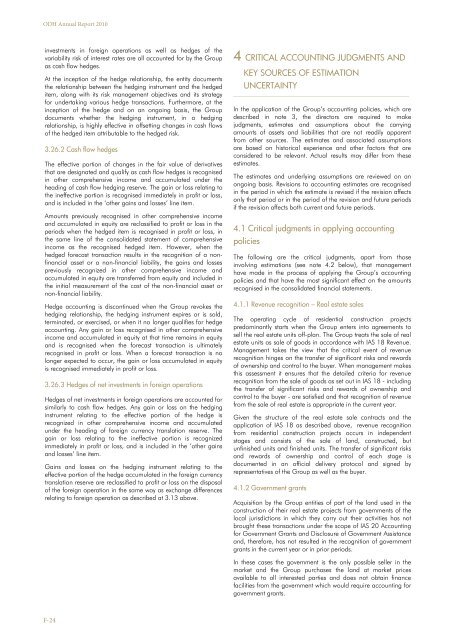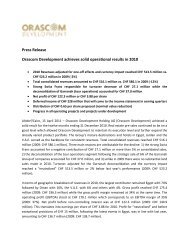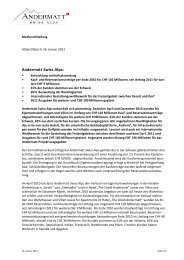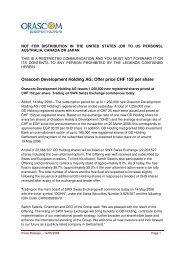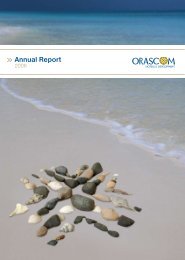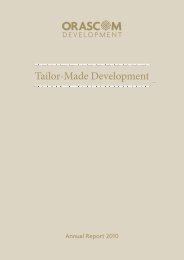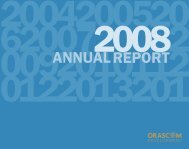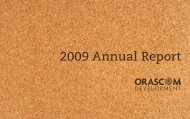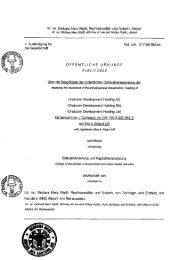FY 2010 Annual Report - Part II - Orascom Development
FY 2010 Annual Report - Part II - Orascom Development
FY 2010 Annual Report - Part II - Orascom Development
You also want an ePaper? Increase the reach of your titles
YUMPU automatically turns print PDFs into web optimized ePapers that Google loves.
ODH <strong>Annual</strong> <strong>Report</strong> <strong>2010</strong><br />
investments in foreign operations as well as hedges of the<br />
variability risk of interest rates are all accounted for by the Group<br />
as cash flow hedges.<br />
At the inception of the hedge relationship, the entity documents<br />
the relationship between the hedging instrument and the hedged<br />
item, along with its risk management objectives and its strategy<br />
for undertaking various hedge transactions. Furthermore, at the<br />
inception of the hedge and on an ongoing basis, the Group<br />
documents whether the hedging instrument, in a hedging<br />
relationship, is highly effective in offsetting changes in cash flows<br />
of the hedged item attributable to the hedged risk.<br />
3.26.2 Cash flow hedges<br />
The effective portion of changes in the fair value of derivatives<br />
that are designated and qualify as cash flow hedges is recognised<br />
in other comprehensive income and accumulated under the<br />
heading of cash flow hedging reserve. The gain or loss relating to<br />
the ineffective portion is recognised immediately in profit or loss,<br />
and is included in the ‘other gains and losses’ line item.<br />
Amounts previously recognised in other comprehensive income<br />
and accumulated in equity are reclassified to profit or loss in the<br />
periods when the hedged item is recognised in profit or loss, in<br />
the same line of the consolidated statement of comprehensive<br />
income as the recognised hedged item. However, when the<br />
hedged forecast transaction results in the recognition of a nonfinancial<br />
asset or a non-financial liability, the gains and losses<br />
previously recognized in other comprehensive income and<br />
accumulated in equity are transferred from equity and included in<br />
the initial measurement of the cost of the non-financial asset or<br />
non-financial liability.<br />
Hedge accounting is discontinued when the Group revokes the<br />
hedging relationship, the hedging instrument expires or is sold,<br />
terminated, or exercised, or when it no longer qualifies for hedge<br />
accounting. Any gain or loss recognised in other comprehensive<br />
income and accumulated in equity at that time remains in equity<br />
and is recognised when the forecast transaction is ultimately<br />
recognised in profit or loss. When a forecast transaction is no<br />
longer expected to occur, the gain or loss accumulated in equity<br />
is recognised immediately in profit or loss.<br />
3.26.3 Hedges of net investments in foreign operations<br />
Hedges of net investments in foreign operations are accounted for<br />
similarly to cash flow hedges. Any gain or loss on the hedging<br />
instrument relating to the effective portion of the hedge is<br />
recognized in other comprehensive income and accumulated<br />
under the heading of foreign currency translation reserve. The<br />
gain or loss relating to the ineffective portion is recognized<br />
immediately in profit or loss, and is included in the ’other gains<br />
and losses’ line item.<br />
Gains and losses on the hedging instrument relating to the<br />
effective portion of the hedge accumulated in the foreign currency<br />
translation reserve are reclassified to profit or loss on the disposal<br />
of the foreign operation in the same way as exchange differences<br />
relating to foreign operation as described at 3.13 above.<br />
4 CRITICAL ACCOUNTING JUDGMENTS AND<br />
KEY SOURCES OF ESTIMATION<br />
UNCERTAINTY<br />
___________________________________________________________________________________<br />
In the application of the Group’s accounting policies, which are<br />
described in note 3, the directors are required to make<br />
judgments, estimates and assumptions about the carrying<br />
amounts of assets and liabilities that are not readily apparent<br />
from other sources. The estimates and associated assumptions<br />
are based on historical experience and other factors that are<br />
considered to be relevant. Actual results may differ from these<br />
estimates.<br />
The estimates and underlying assumptions are reviewed on an<br />
ongoing basis. Revisions to accounting estimates are recognised<br />
in the period in which the estimate is revised if the revision affects<br />
only that period or in the period of the revision and future periods<br />
if the revision affects both current and future periods.<br />
4.1 Critical judgments in applying accounting<br />
policies<br />
The following are the critical judgments, apart from those<br />
involving estimations (see note 4.2 below), that management<br />
have made in the process of applying the Group’s accounting<br />
policies and that have the most significant effect on the amounts<br />
recognised in the consolidated financial statements.<br />
4.1.1 Revenue recognition – Real estate sales<br />
The operating cycle of residential construction projects<br />
predominantly starts when the Group enters into agreements to<br />
sell the real estate units off-plan. The Group treats the sale of real<br />
estate units as sale of goods in accordance with IAS 18 Revenue.<br />
Management takes the view that the critical event of revenue<br />
recognition hinges on the transfer of significant risks and rewards<br />
of ownership and control to the buyer. When management makes<br />
this assessment it ensures that the detailed criteria for revenue<br />
recognition from the sale of goods as set out in IAS 18 - including<br />
the transfer of significant risks and rewards of ownership and<br />
control to the buyer - are satisfied and that recognition of revenue<br />
from the sale of real estate is appropriate in the current year.<br />
Given the structure of the real estate sale contracts and the<br />
application of IAS 18 as described above, revenue recognition<br />
from residential construction projects occurs in independent<br />
stages and consists of the sale of land, constructed, but<br />
unfinished units and finished units. The transfer of significant risks<br />
and rewards of ownership and control of each stage is<br />
documented in an official delivery protocol and signed by<br />
representatives of the Group as well as the buyer.<br />
4.1.2 Government grants<br />
Acquisition by the Group entities of part of the land used in the<br />
construction of their real estate projects from governments of the<br />
local jurisdictions in which they carry out their activities has not<br />
brought these transactions under the scope of IAS 20 Accounting<br />
for Government Grants and Disclosure of Government Assistance<br />
and, therefore, has not resulted in the recognition of government<br />
grants in the current year or in prior periods.<br />
In these cases the government is the only possible seller in the<br />
market and the Group purchases the land at market prices<br />
available to all interested parties and does not obtain finance<br />
facilities from the government which would require accounting for<br />
government grants.<br />
F-24


